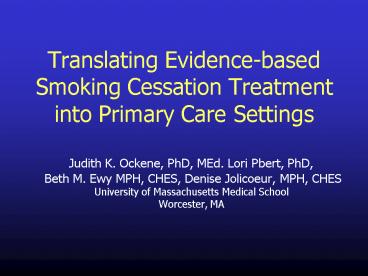Translating Evidencebased Smoking Cessation Treatment into Primary Care Settings - PowerPoint PPT Presentation
1 / 26
Title:
Translating Evidencebased Smoking Cessation Treatment into Primary Care Settings
Description:
Translating Evidence-based Smoking Cessation Treatment into Primary Care Settings ... Worcester, MA. In this presentation I will review: ... – PowerPoint PPT presentation
Number of Views:133
Avg rating:3.0/5.0
Title: Translating Evidencebased Smoking Cessation Treatment into Primary Care Settings
1
Translating Evidence-based Smoking Cessation
Treatment into Primary Care Settings
- Judith K. Ockene, PhD, MEd. Lori Pbert, PhD,
- Beth M. Ewy MPH, CHES, Denise Jolicoeur, MPH,
CHES - University of Massachusetts Medical School
- Worcester, MA
2
In this presentation I will review
- The importance of the primary care setting for
delivering tobacco treatment - The evidence base for smoking cessation treatment
in primary care settings - The key components necessary for translating
smoking cessation treatment into primary care - Barriers and facilitators to implementing
evidence-based treatment strategies
3
Primary Care Physicians/Settings are Important
for Prevention and Intervention
- Provide continuity of care
- 80 of adults visit a MD/year
- Credible information source
- People are aware of their health when visiting a
MD/PC setting - Can refer to other providers
- They are effective!
4
The Evidence Base A Clinical Practice
Guideline for Treating Tobacco Use and Dependence
U.S. Public Health Service Agency for Healthcare
Research Quality Issued June 2000
5
Major Conclusions
- It is essential that clinicians and health care
delivery systems (including insurers and
purchasers) institutionalize the identification,
documentation and treatment of every tobacco user.
6
Efficacy of Office Systems to Identify Tobacco
Users at Each Clinical Encounter
(Meta-Analysis of 3 Studies)
7
Systematic Identification and Documentation of
Tobacco Users
- Vital signs stamp
- Patient assessment form
- Chart stickers
- Electronic medical record prompts
8
Major Conclusions
- Brief tobacco dependence treatment is effective,
and every patient who uses tobacco should be
offered at least brief treatment.
9
Brief 5A Intervention Model
- Ask about tobacco use at every visit
- Advise all tobacco users to quit
- Assess willingness to quit
- Assist the patient in quitting
- Arrange follow-up contact
10
Implementation of the 5As at 2 Sites
11
Possible Reasons for Greater Implementation of
5As at UMMHC
- Periodic training sessions expose providers to
the 5A model for multiple health risk behaviors - System for screening and documenting smoking
status has been institutionalized - Reminder system (problem list) includes smoking
- Clinical culture supports patient-centered
approach to preventive counseling - Patients were more likely to report being asked
about interest in quitting (81 vs. 53)
suggests clinicians more prepared to provide
cessation assistance
12
Major Conclusions
- There is a strong dose-response relationship
between the intensity of tobacco dependence
counseling and its effectiveness - The more contact, the higher the quit rate.
13
Estimated Abstinence Rates by Length of Contact
(n43 studies)
14
Major Conclusions
- Effective pharmacotherapies for quitting smoking
now exist.
15
Pharmacotherapies
- Five first-line therapies have been
- identified as effective
- -- Nicotine patch
- -- Nicotine gum
- -- Nicotine nasal spray
- -- Nicotine inhaler
- -- Zyban (bupropion hydrochloride)
- Nicotine lozenge added Nov. 2002
16
Translating Evidence-based Strategies into the
Primary Care Setting Key Components
17
Key Components of Effective Tobacco Treatment
- Routinely screen and document tobacco use
- Prompt/cue provider to conduct intervention
- Use a method for documenting each tobacco
- use cessation encounter
- Make self-help materials available
- Use a follow-up system, including referral to
- internal and external resources
- Use a feedback system to staff
18
Example QuitWorks
- Linking
- Eight Massachusetts commercial and Medicaid
health plans - 15,000 providers
- Hospitals and health centers in Massachusetts
- All patients who use tobacco regardless of health
insurance - Proactive telephone counseling _at_ Try-To-STOP
TOBACCO Resource Center
Supported by the health plans and the Mass. Dept.
of Public Health
19
Example QuitWorks
20
QuitWorks Implementation Phases
I. Promotion to primary care practices by
health plan representatives II. Response to
interest by hospitals for inpatient and
outpatient implementation III. Plans to tailor
for use by community health centers
21
Barriers and Facilitators to the Implementation
and Maintenance of Evidence-based Treatment
Strategies
22
Barriers to Implementation/Maintenance
- Lack of time
- Perceived lack of skills to treat
- Lack of administrative support/Not perceived as a
priority - Treatment not viewed as effective
- Lack of reimbursement
- Institutional lethargy
23
Strategies to Facilitate Implementation
- Find and nurture a champion within your
institution - Bring together an implementation
- group with decision-making authority
- Find internal motivators such as QA reviews,
JCAHO or HEDIS
24
Strategies to Facilitate Implementation (Cont.)
- Educate providers about the effectiveness of
brief interventions - Build on previous system changes
- Develop links with internal and external
treatment resources, including quitlines,
websites, voluntary agencies, local treatment
specialists,resource or prevention centers
25
Training to Enhance Implementation/Maintenance
3 Levels of Training 1. Office staff to
implement and maintain office system
2. Health care providers to deliver brief
intervention 3. Tobacco Treatment
Specialists to provide more intensive
counseling CONSIDER ALL THREE!
26
Conclusions
- Tobacco dependence treatment is effective
- The primary care setting is an important place
for delivery of tobacco treatment - Key components can be implemented to facilitate
tobacco dependence treatment - Training should be available to clinicians and
staff - Links need to be developed with internal and
external resources































